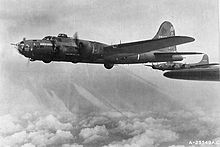323d Strategic Reconnaissance Squadron
This article includes a list of references, related reading or external links, but its sources remain unclear because it lacks inline citations. (December 2012) |
| 323d Strategic Reconnaissance Squadron | |
|---|---|
 Emblem of the 323d Strategic Reconnaissance Squadron | |
| Active | 1942–1945; 1947–1957 |
| Country | United States |
| Branch | United States Air Force |
| Type | Strategic Reconnaissance |



The 323d Strategic Reconnaissance Squadron is an inactive United States Air Force unit. Its last was assigned to the 91st Strategic Reconnaissance Wing, stationed at Lockbourne Air Force Base, Ohio. It was inactivated on 8 November 1957.
History[]
Established as a B-17 Flying Fortress heavy bomb squadron in early 1942; trained under Third Air Force in the southeastern United States with final training under Second Air Force in Washington. Deployed to European Theater of Operations (ETO), assigned to VIII Bomber Command in England, being one of the first heavy bomb squadrons arriving in England. The 323d was one of the most highly decorated strategic heavy bomb squadrons in the European Theater, flying combat missions over Nazi Germany and Occupied Europe until the German capitulation in May 1945. Most personnel demobilized in England immediately after the end of the war in Europe, Squadron returned to the United States with a small headquarters staff and was planned to be re-equipped and remanned as a B-29 Superfortress squadron. Japanese capitulation canceled plans and was inactivated as a paper unit in the United States during November 1945.
Reactivated in 1947 as a Strategic Air Command long-range strategic reconnaissance squadron; not manned or equipped until July 1948. Used B-17 and B-29 bombers refitted for reconnaissance missions. Deployed to Japan in 1950, and performed strategic reconnaissance missions over Korea, and the Northern Pacific coast of Communist China and the Soviet Union. Re-equipped with RB-45C Tornado jet reconnaissance aircraft, flying reconnaissance and mapping combat missions over Korea until being assigned to the United States in mid 1952. Re-equipped with RB-47E Stratojets, performed various reconnaissance missions on a worldwide scale until inactivation in 1957.
Lineage[]
- Constituted 323d Bombardment Squadron (Heavy) on 28 January 1942
- Activated on 15 April 1942
- Inactivated on 7 November 1945
- Redesignated 323d Reconnaissance Squadron on 11 June 1947
- Activated on 1 July 1947
- Redesignated: 323d Strategic Reconnaissance Squadron on 10 November 1948
- Redesignated: 323d Strategic Reconnaissance Squadron (Medium) on 6 July 1950
- Inactivated on 8 November 1957
Assignments[]
- 91st Bombardment Group, 15 April 1942 – 7 November 1945
- 91st Reconnaissance (later Strategic Reconnaissance) Group, 1 July 1947
- 91st Strategic Reconnaissance Wing, 28 May 1952 – 8 November 1957
Stations[]
- Harding Army Air Field, Louisiana, 15 April 1942
- MacDill Field, Florida, 16 May 1942
- Walla Walla Army Air Base, Washington, c. 28 June-24 August 1942
- RAF Kimbolton (AAF-117), England, 13 September 1942 (ground echelon), early October 1942 (air echelon)
- RAF Bassingbourn (AAF-121), England, 14 October 1942 – 23 June 1945
- Drew Field, Florida, 3 July-7 November 1945
- Andrews Field, Maryland, 1 July 1947
- McGuire AFB, New Jersey, 19 July 1948
- Barksdale AFB, Louisiana, 1 October 1949
- Deployed to Johnson AB and Yokota AB, Japan 6 July 1950 – 28 May 1952
- Lockbourne AFB, Ohio, 11 September 1951 – 8 November 1957
Aircraft[]
- B-17 Flying Fortress, 1942–1945
- RB-17 Flying Fortress, 1948–1949
- RB-29 Superfortress, 1949–1950
- RB-45C Tornado, 1950–1953
- RB-47E Stratojet, 1953–1957
References[]
![]() This article incorporates public domain material from the Air Force Historical Research Agency website http://www.afhra.af.mil/.
This article incorporates public domain material from the Air Force Historical Research Agency website http://www.afhra.af.mil/.
- Maurer, Maurer, ed. (1983) [1961]. Air Force Combat Units of World War II (PDF) (reprint ed.). Washington, DC: Office of Air Force History. ISBN 0-912799-02-1. LCCN 61060979.
- Maurer, Maurer, ed. (1982) [1969]. Combat Squadrons of the Air Force, World War II (PDF) (reprint ed.). Washington, DC: Office of Air Force History. ISBN 0-405-12194-6. LCCN 70605402. OCLC 72556.
- Strategic Air Command units
- Reconnaissance squadrons of the United States Air Force